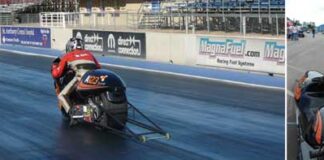Aluminum sheets are a popular material for many of our experimental aircraft designs. It’s no wonder that there are wide varieties of hand tools that can be used for cutting these sheets into useful parts. While hand aviation snips may be the most commonly used tools for this purpose, they do have their limitations. The teeth and shearing motion of their design produce a cut edge with a slight wavy distortion including teeth marks. The builder’s ability to precisely follow the cut line determines how straight the edge will form.
Builders that scratch build their aircraft directly from plans rather than assembling from a kit will have many more sheet aluminum cuts to perform to create their aircraft parts. Some of these cuts can be quite long (the edges of a wing for example). While there are bench-mounted shearing tools available, some builders prefer to use an inexpensive hand tool that has the ability to produce “perfect” cuts—with flawless straight edges free of distortion and teeth marks. This hand tool is the OLFA knife.
I was introduced to the OLFA knife 15 years ago by a builder who created every metal part for his aircraft from scratch. He had a lot of sheet aluminum cutting in his project and accomplished it all with a single OLFA knife and a couple blades. Back in those days this knife was available for purchase from Amazon.com and other specialty stores, but apparently it has really caught on over the years because now Aircraft Spruce carries this tool. The part number for this unique knife is OLFA PC-L (the handle) with PB-800 blades, and it sells for about $10 to $12. This knife is designed for cutting laminates and plastics, but it also does a wonderful job on aluminum sheet. OLFA is a Japanese manufacturer of utility knives dating back to 1956 and is credited with inventing the snap-off blade and rotary cutter.
Originally designed for cutting laminates and plastics, this OLFA knife also works great on aluminum sheet.
Making cuts with the knife is straightforward: the tungsten steel blade is dragged (scored) across the sheet from one end of the cut line to the other several times. The number of repetitive scores depends on the downward force that is used as well as the thickness of the sheet being cut. For example: .025-inch-thick aluminum sheets require about 12 strokes of the knife with moderate pressure. You do not need to cut all of the way through the sheet. When the blade has reached about 90% of the way through the sheet, simply bend the material along the cut line once or twice and a very clean separation will occur. There is a benefit to not cutting all the way through the sheet. Scoring can never be completed perfectly evenly across the entire stretch, and the knife will snag if trying to cut all the way through.
In order to repeat the scoring in exactly the same groove that is formed with each pass, it is important to use a straightedge of some sort to guide the knife. An aluminum sheet clamped in a bending brake can use the edge of the brake for this purpose. A metal ruler held tightly to the surface works just fine, too. The resulting cut edges are as straight as can be. The edges will be sharp and need a quick deburring before use.
If you are not in a hurry, nothing beats the cuts this simple tool can make. I have participated in making eight-foot-long cuts. Your hand does not fatigue like it does when using conventional hand snips on those long cuts. And the resulting edges are as good as any factory cut—which cannot be duplicated easily with hand snips. A perfect cut for about $10 to $12, plane and simple!















